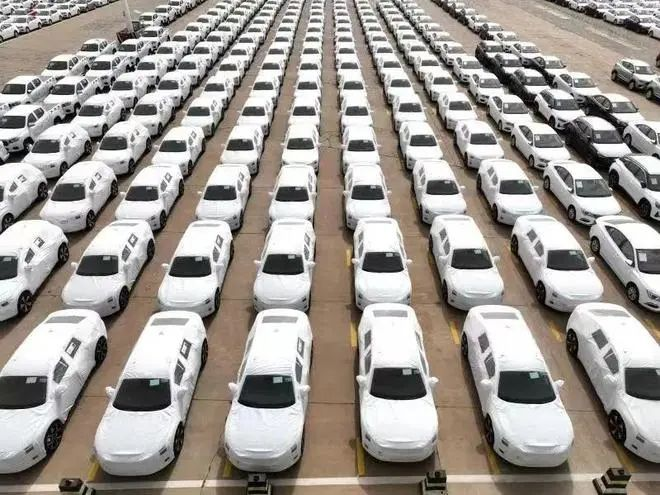April exports from China grew by 8.5% year-on-year in US dollar terms, surpassing expectations.
On Tuesday, May 9th, the General Administration of Customs released data indicating that China’s total imports and exports reached $500.63 billion in April, marking a 1.1% increase. Specifically, exports amounted to $295.42 billion, rising by 8.5%, while imports reached $205.21 billion, reflecting a decline of 7.9%. Consequently, the trade surplus expanded by 82.3%, reaching $90.21 billion.
In terms of the Chinese yuan, China’s imports and exports for April totaled ¥3.43 trillion, representing an 8.9% increase. Among these, exports accounted for ¥2.02 trillion, growing by 16.8%, while imports amounted to ¥1.41 trillion, decreasing by 0.8%. Consequently, the trade surplus expanded by 96.5%, reaching ¥618.44 billion.
Financial analysts suggest that the continued positive year-on-year export growth in April can be attributed to the low base effect.
During April 2022, Shanghai and other areas experienced a peak in COVID-19 cases, resulting in a significantly lower export base. This low base effect primarily contributed to the positive year-on-year export growth in April. However, the month-on-month export growth rate of 6.4% was notably lower than the normal seasonal fluctuation level, indicating relatively weak actual export momentum for the month, aligning with the global trend of slowing trade.
Analyzing key commodities, the export of automobiles and ships played a significant role in driving the performance of foreign trade in April. Based on calculations in Chinese yuan, the export value of automobiles (including chassis) witnessed a year-on-year growth of 195.7%, while ship exports surged by 79.2%.
In terms of trading partners, the number of countries and regions experiencing a decline in cumulative year-on-year trade value growth during the period from January to April decreased to five, compared to the previous month, with the rate of decline narrowing.
Exports to ASEAN and the European Union show growth, while those to the United States and Japan decline.
According to customs data, in April, among the top three export markets, China’s exports to ASEAN grew by 4.5% year-on-year in US dollar terms, exports to the European Union increased by 3.9%, while exports to the United States declined by 6.5%.
During the first four months of the year, ASEAN remained China’s largest trading partner, with bilateral trade reaching ¥2.09 trillion, representing a growth of 13.9% and accounting for 15.7% of China’s total foreign trade value. Specifically, exports to ASEAN amounted to ¥1.27 trillion, growing by 24.1%, while imports from ASEAN reached ¥820.03 billion, growing by 1.1%. Consequently, the trade surplus with ASEAN expanded by 111.4%, reaching ¥451.55 billion.
The European Union ranked as China’s second-largest trading partner, with bilateral trade reaching ¥1.8 trillion, growing by 4.2% and accounting for 13.5%. Specifically, exports to the European Union amounted to ¥1.17 trillion, growing by 3.2%, while imports from the European Union reached ¥631.35 billion, growing by 5.9%. Consequently, the trade surplus with the European Union expanded by 0.3%, reaching ¥541.46 billion.
“ASEAN continues to be China’s largest trading partner, and expanding into ASEAN and other emerging markets provides more resilience for Chinese exports.” Analysts believe that the Sino-European economic and trade relationship is showing a positive trend, making ASEAN’s trade relationship a solid support for foreign trade, suggesting potential future growth.
Notably, China’s exports to Russia experienced a substantial year-on-year increase of 153.1% in April, marking two consecutive months of triple-digit growth. Analysts suggest that this is mainly due to Russia redirecting its imports from Europe and other regions to China against the backdrop of intensified international sanctions.
However, analysts caution that although China’s foreign trade has recently shown unexpected growth, it is likely attributed to the digestion of backlog orders from the fourth quarter of the previous year. Considering the recent significant decline in exports from neighboring countries such as South Korea and Vietnam, the overall global external demand situation remains challenging, indicating that China’s foreign trade still faces severe challenges.
Surge in Automobile and Ship Exports
Among key export commodities, in US dollar terms, the export value of automobiles (including chassis) increased by 195.7% in April, while ship exports grew by 79.2%. Additionally, the export of cases, bags, and similar containers witnessed a growth of 36.8%.
The market has widely noted that automobile exports maintained a rapid growth rate in April. Data shows that from January to April, the export value of automobiles (including chassis) grew by 120.3% year-on-year. According to calculations by institutions, the export value of automobiles (including chassis) increased by 195.7% year-on-year in April.
Currently, the industry remains optimistic about China’s automobile export prospects. The China Association of Automobile Manufacturers predicts that domestic automobile exports will reach 4 million vehicles this year. Furthermore, some analysts believe that China is likely to surpass Japan and become the world’s largest automobile exporter this year.
Cui Dongshu, Secretary-General of the Joint Conference of the National Passenger Vehicle Market Information, stated that China’s automobile export market has demonstrated strong growth in the past two years. The export growth is mainly driven by the surge in exports of new energy vehicles, which have seen significant growth in both export volume and average price.
“Based on the tracking of China’s automobile exports to overseas markets in 2023, exports to major countries have shown strong growth. Although exports to the southern hemisphere have declined, exports to developed countries have shown high-quality growth, indicating overall positive performance for automobile exports.”
The United States ranks as China’s third-largest trading partner, with bilateral trade reaching ¥1.5 trillion, declining by 4.2% and accounting for 11.2%. Specifically, exports to the United States amounted to ¥1.09 trillion, declining by 7.5%, while imports from the United States reached ¥410.06 billion, growing by 5.8%. Consequently, the trade surplus with the United States narrowed by 14.1%, reaching ¥676.89 billion. In US dollar terms, China’s exports to the United States declined by 6.5% in April, while imports from the United States dropped by 3.1%.
Japan ranks as China’s fourth-largest trading partner, with bilateral trade reaching ¥731.66 billion, declining by 2.6% and accounting for 5.5%. Specifically, exports to Japan amounted to ¥375.24 billion, growing by 8.7%, while imports from Japan reached ¥356.42 billion, declining by 12.1%. Consequently, the trade surplus with Japan amounted to ¥18.82 billion, compared to a trade deficit of ¥60.44 billion during the same period last year.
During the same period, China’s total imports and exports with countries along the Belt and Road Initiative (BRI) reached ¥4.61 trillion, growing by 16%. Among these, exports amounted to ¥2.76 trillion, growing by 26%, while imports reached ¥1.85 trillion, growing by 3.8%. Specifically, trade with Central Asian countries, such as Kazakhstan, and West Asian and North African countries, such as Saudi Arabia, increased by 37.4% and 9.6%, respectively.
Cui Dongshu further explained that there is currently a significant demand for new energy vehicles in Europe, providing excellent export opportunities for China. However, it should be noted that the export market for China’s domestic new energy brands is subject to significant fluctuations.
Meanwhile, the export of lithium batteries and solar panels continued to grow rapidly in April, reflecting the promotion effect of China’s manufacturing industry transformation and upgrading on exports.
Post time: May-17-2023









